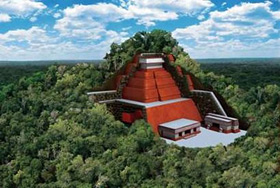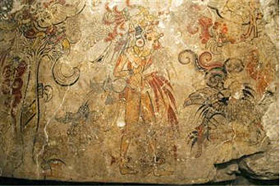Oldest Maya Mural Uncovered in Guatemala
 Randolph E. Schmid - Associated Press Randolph E. Schmid - Associated Press


| | An artist's rendition shows a cut-away view of a recently excavated Maya tomb in San Bartolo, Guatemala. (Art by Vlad Dumitrascu) | 
| | A detail from a sacred Maya mural at San Bartolo, the earliest known Maya painting, depicting the birth of the cosmos and the divine right of a king, shows the son of the corn god, patron of kings, floating with a pair of birds tied to his woven hunting basket, letting blood and offering a sacrificed turkey before one of five cosmic trees. |
Archaeologist William Saturno said Tuesday he was awe-struck when he uncovered a Maya mural not seen for nearly two millennia. Discovered at the San Bartolo site in Guatemala, the mural covers the west wall of a room attached to a pyramid, Saturno said at a briefing.

In brilliant color, the mural tells the Maya story of creation, he said. It was painted about 100 B.C., but later covered when the room was filled in.

"It could have been painted yesterday," Saturno said in a briefing organized by the National Geographic Society, which supported his work and will detail the finding in the January issue of its magazine.

Saturno, of the University of New Hampshire, first reported discovery of the site in 2002 when he stopped to rest in the jungle, taking shelter in an old trench that turned out to be part of the ancient room.

Since then the west and north walls have been uncovered. The room's other walls had been demolished and used for fill, he said. The west wall was the centerpiece of the room, Saturno said.

The mural includes four deities, which are variations of the same figure, the son of the corn god.

As Saturno explained it: The first deity stands in the water and offers a fish, establishing the watery underworld. The second stands on the ground and sacrifices a deer, establishing the land. The third floats in the air, offering a turkey, establishing the sky. The fourth stands in a field of flowers, the food of gods, establishing paradise.

Another section shows the corn god crowning himself king upon a wooden scaffold, and the final section shows a historic coronation of a Maya king.

Some of the writing can be understood, Saturno said, but much of it is so old it is hard to decipher.

Nearby, archaeologists led by Guatemalan Monica Pellecer Alecio found the oldest known Maya royal burial, from around 150 B.C. Excavating beneath a small pyramid, that team found a burial complex that included ceramic vessels and the bones of a man, with a jade plaque the symbol of Maya royalty on his chest.

On the Net: National Geographic: http://www.nationalgeographic.com |



